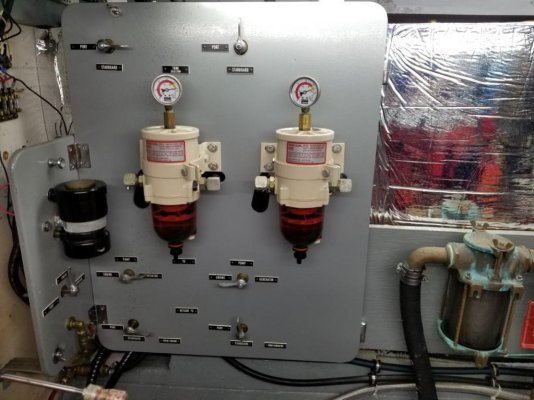Hi Rich.Been following your blogs from back in the yahoo days. When both tanks are full and return lines are open I get diesel coming out of my starboard fuel overflow outside the boat. So I closed the starboard return line to 2/3 open and fuel stopped flowing out starboard breather. Unfortunately my fuel gauges are not working so I'm est. 6 gph @ 2000 rpm. We ran for 34.5 hrs and came up with about 200 gallons used. Tapping on the port side tank it sounded bone dry but didn't have time to check out the starboard tank but I think there should be about 100 gallons . If all fuel lines are open and one tank is dry would I be sucking air out of the dry tank?
thanks for any info
Cheers J.T
JT, here's a stream-of-consciousness piece about your issue:
How is fuel drawn from your tanks, through the top with a standpipe or from the bottom?
The venting overboard of fuel is cause for concern that something is wrong, especially if you end up with a huge disparity in fuel levels after running both tanks with their supply valves open. Without a verifiable fuel level indicator for the tanks, you are sort of shooting in the dark, but my first guess is that the problem lies within the high-fuel-level tank, either an air leak in a standpipe or its valve and connections on top of the tank or a clog in the bottom of the standpipe or clog in the exit at a bottom feed system, if that is what you have.
Like you, I suspect that were you to continue to draw fuel from the low-level tank while carrying a high fuel level in the other that you could eventually draw air into the engine's fuel. Shutting off the low tank to force draw from the high tank might do the same if there is indeed a slow air ingestion issue with a standpipe system. Can you get full RPM at WOT drawing from the high tank? Do you have a vacuum gauge in the fuel supply like on top of a Racor filter? A high vacuum with an otherwise clean filter would indicate a clog in the tank.
My boat model has some inherent off-center weight which results in a little bit of a list when the two fuel cross-connection valves are both open with the boat off the list and in the water. I got a bit frustrated and replaced the cross-connection hose to no avail. I checked the flow out of both my bottom-feed tank valves by momentarily opening them into a quart jar. All good.
This double checking of shifting fuel was made possible by the sight gauge I installed into the cross-connection hose. Just close the tank valves and cut the hose to insert a brass or bronze tee with appropriate hose barbs and a valve leading to a vertically oriented clear vinyl hose with another valve at the top end a bit higher than the tank tops. Open the two sight gauge valves and one of the tank supply valves to get its level. Reclose the tank valve and open the opposite one to get its fuel level. Then close both valves in the sight gauge and finish with both tank valves open. I think the installation took me 30 minutes.
I find your 2000 RPM fuel use rather high compared to my 315-HP Yanmar 6LPA-STP which gets the following (3,2 GPH burned at 2000) as measured by my Floscan:
RPM Input Return Burned
725 8.0 7.4 0.6
1000 9.0 8.2 0.8
1500 11.1 9.3 1.8
1800 12.4 9.9 2.5
2000 13.3 10.1 3.2
2500 16.6 10.8 5.8
2800 18.6 11.2 7.4
3000 20.0 11.4 8.6
3200 21.8 11.8 10.0
3400 23.7 11.9 11.8
The return flow is quite brisk and can cause overflow in a nearly full tank which is not draining via a cross connection hose in short order.

